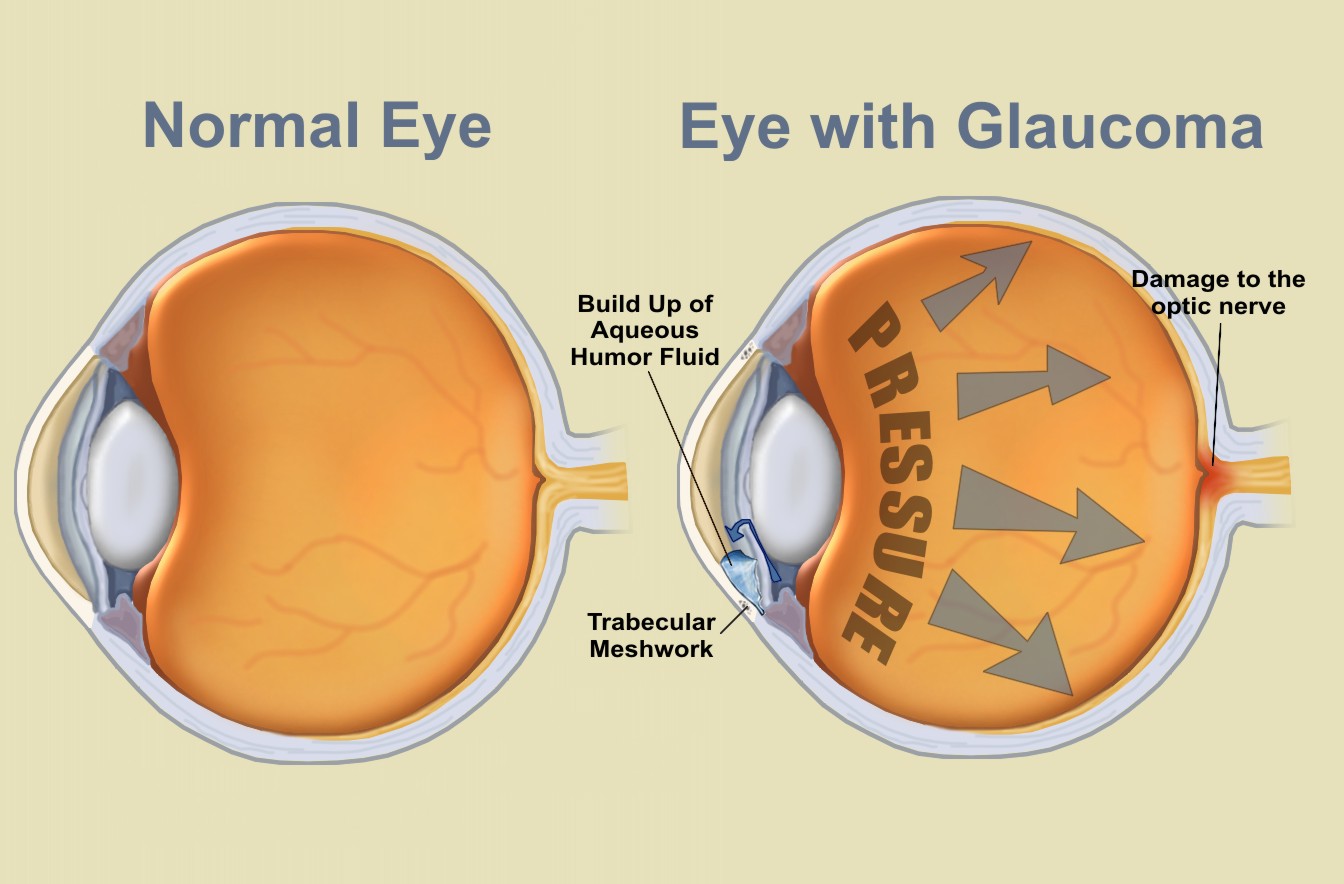
GLAUCOMA

Glaucoma is a group of eye conditions that damage the optic nerve, which is vital to good vision. This damage is often caused by an abnormally high pressure in your eye.
Glaucoma is one of the leading causes of blindness in the United States. It can occur at any age but is more common in older adults. The most common form of glaucoma has no warning signs. The effect is so gradual that you may not notice a change in vision until the condition is at an advanced stage.
Vision loss due to glaucoma can't be recovered. So it's important to have regular eye exams that include measurements of your eye pressure. If glaucoma is recognized early, vision loss can be slowed or prevented. If you have the condition, you'll generally need treatment for the rest of your life.
Symptoms. The signs and symptoms of glaucoma vary depending on the type and stage of your condition. For example:
Open-angle glaucoma
Patchy blind spots in your side
(peripheral) or central vision, frequently in both eyes.
Tunnel vision in the advanced stages
Acute angle-closure glaucoma
Severe headache; Eye pain; Nausea and vomiting; Blurred vision; Halos around lights; Eye redness
If left untreated, glaucoma will eventually cause blindness. Even with treatment, about 15 percent of people with glaucoma become blind in at least one eye within 20 years.
When to see a doctor
Seek immediate medical care. Promptly go to an emergency room or an eye doctor's (ophthalmologist's) office if you experience some of the symptoms of acute angle-closure glaucoma, such as severe headache, eye pain and blurred vision.
Schedule eye exams
Open-angle glaucoma gives few warning signs until permanent damage has already occurred. Regular eye exams are the key to detecting glaucoma early enough to successfully slow or prevent vision loss.
The American Academy of Ophthalmology recommends glaucoma screening every four years beginning at age 40 if you don't have any glaucoma risk factors. Every two years if you're at high risk or over 65
Causes
Glaucoma is the result of damage to the optic nerve. This nerve damage is usually related to increased pressure in the eye. Elevated eye pressure is due to a buildup of a fluid that flows throughout your eye. This fluid normally drains into the front of the eye through tissue at the angle where the iris and cornea meet. When fluid is overproduced or the drainage system doesn't work properly, the fluid can't flow out at its normal rate and pressure builds up.
Glaucoma tends to run in families. In some people, scientists have identified genes related to high eye pressure and optic nerve damage.
Risk factors
Because chronic forms of glaucoma can destroy vision before any signs or symptoms are apparent, be aware of these risk factors:
Having high internal eye pressure
(intraocular pressure); Being over age 60; Being black or Hispanic; Having a
family history of the condition; Having certain medical conditions, such as
diabetes, heart disease, high blood pressure and sickle cell anemia; Having
certain eye conditions, such as nearsightedness; Having had an eye injury or
certain types of eye surgery; Early estrogen deficiency, such as can occur after
removal of both ovaries (bilateral oophorectomy) before age 43; Taking
corticosteroid medications, especially eye drops, for a long time.
Prevention
You may not be able to prevent glaucoma. But these self-care steps can help you detect it early, limit vision loss or slow its progress.
Get regular eye care. Regular comprehensive eye exams can help detect glaucoma in its early stages before irreversible damage occurs. As a general rule, have comprehensive eye exams every four years beginning at age 40 and every two years from age 65. You may need more frequent screening if you're at high risk of glaucoma. Ask your doctor to recommend the right screening schedule for you.
Know your family's eye health history. Glaucoma tends to run in families. If you're at increased risk, you may need more frequent screening.
Exercise safely. Regular, moderate exercise may help prevent glaucoma by reducing eye pressure. Talk with your doctor about an appropriate exercise program.
Take prescribed eye drops regularly. Glaucoma eye drops can significantly reduce the risk that high eye pressure will progress to glaucoma. To be effective, eye drops prescribed by your doctor need to be used regularly even if you have no symptoms.
Wear eye protection. Serious eye injuries can lead to glaucoma. Wear eye protection when using power tools or playing high-speed racket sports on enclosed courts.
Reference: Web MD.